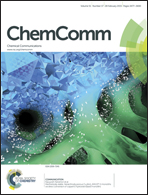A new turn on Pd2+-specific fluorescence probe and its use as an imaging reagent for cellular uptake in Hct116 cells†
Abstract
A new coumarin–rhodamine conjugate is used as a specific probe for Pd2+ ions and this could even delineate Pd(II) from Pd(0) or Pd(IV) in aqueous buffer medium (pH ∼ 7). Laser confocal microscopic studies reveal that efficient cellular internalization of this reagent helps in imaging the cellular uptake of Pd2+ as low as 0.1 ppm in Hct 116 cells. This reagent could even be used for estimation of Pd2+ in human urine samples.


 Please wait while we load your content...
Please wait while we load your content...